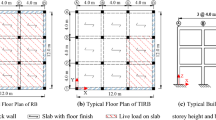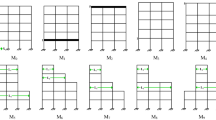Abstract
The non-structural components play a vital role in industrial buildings. The past study indicates that the non-structural components damage loss surpass the structural damage loss. As a result, after an earthquake in critical, essential, and lifeline buildings, non-structural components that must be in operational conditions are essential. Industrial buildings accommodate a wide range of processes and provide workers with the necessary equipment for efficient industrial operations. The centre of mass and the centre of stiffness or rigidity in the building do not align because of the irregular distribution of floor mass, inducing torsion in the building. According to Indian Standard (IS 1893-part 4:2015), linear time history analysis with design basis earthquake is required to generate floor response spectra for use in non-structural component design. Thus, linear time history analysis was initially performed to generate floor response spectra, and then work was extended with nonlinear time history analysis. The primary goal of this present study is to focus on the impact of torsional irregularity on the floor response continuum with tri-directional earthquake time histories. Regular and torsional irregular buildings with G + 2 storeys are considered for this. The building location is considered in the highest seismic zone in India and positioned on medium soil. The study concluded that torsional irregularity in the structure resulted in floor response spectra in the two orthogonal horizontal and vertical directions with significant design forces for each direction of earthquake excitation. Thus, the structural designer must employ these three direction response spectra for precise and protective non-structural support design.











Similar content being viewed by others
References
D. Perrone, P.M. Calvi, R. Nascimbene, E.C. Fischer, G. Magliulo, Seismic performance of non-structural elements during the 2016 Central Italy earthquake. Bull. Earthq. Eng. 17(10), 5655–5677 (2019). https://doi.org/10.1007/s10518-018-0361-5
J.M. Biggs, J.M. Roesset, Seismic analysis of equipment mounted on a massive structure. In Seismic Design of Nuclear Power Plants (MIT Press, Cambridge, 1970)
USNRC Regulatory Guide 1.122, Development of floor design response spectra for seismic design of floor-supported equipment or components. Rev. 1. (1978)
C. Adam, Dynamics of elastic-plastic shear frames with secondary structures: Shake table and numerical studies. Earthq. Eng. Struct. Dyn. 30(2), 257–277 (2001). https://doi.org/10.1002/1096-9845(200102)30:2%3c257:AID-EQE7%3e3.0.CO;2-J
A.K. Agarwal, T.K. Datta, Response of multiple-supported secondary system on torsionally coupled yielding primary system. Adv. Vib. Eng. 2(4), 115–124 (2003)
M. Amin, W.J. Hall, N.M. Newmark, R.P. Kassawara, Earthquake response of multiply connected light secondary systems by spectrum methods. In Proceedings of the 1st National Conference on Pressure Vessels and Piping, New York, pp. 103–129 (1971)
B.A. Bradley, A ground motion selection algorithm based on the generalized condition intensity measure approach. Soil Dyn. Earthq. Eng. 40, 48–61 (2012). https://doi.org/10.1016/j.soildyn.2012.04.007
A. Lucchini, P. Franchin, F. Mollaioli, Spectrum-to-spectrum methods for the generation of elastic floor acceleration spectra. Procedia Eng. 199, 3552–3557 (2017). https://doi.org/10.1016/j.proeng.2017.09.514
A. Menon, G. Magenes, Definition of seismic input for out-of-plane response of masonry walls: II. Formulation. J. Earthq. Eng. 15(2), 195–213 (2011). https://doi.org/10.1080/13632460903456981
A.K. Singh, A.H. Ang, Stochastic prediction of maximum seismic response of light secondary systems. Nucl. Eng. Des. 29(2), 218–230 (1974). https://doi.org/10.1016/0029-5493(74)90124-1
M.P. Singh, Seismic design input for secondary systems. J. Struct. Div. 106(2), 505–517 (1980). https://doi.org/10.1061/JSDEAG.0005371
M. Surana, Y. Singh, D.H. Lang, Floor spectra of inelastic RC frame buildings considering ground motion characteristics. J. Earthq. Eng. 22(3), 488–519 (2018). https://doi.org/10.1080/13632469.2016.1244134
R. Villaverde, Seismic Analysis and Design of Nonstructural Components. Earthquake Engineering: From Engineering Seismology to Performance-Based Engineering (CRC, Boca Raton, 2004), pp. 1156–1220
V. Vukobratovic, P. Fajfar, A method for the direct determination of approximate floor response spectra for SDOF inelastic structures. Bull. Earthq. Eng. 13(5), 1405–1424 (2015). https://doi.org/10.1007/s10518-014-9667-0
R.A. Medina, R. Sankaranarayanan, K.M. Kingston, Floor response spectra for light components mounted on regular moment-resisting frame structures. Eng. Struct. 28(14), 1927–1940 (2006). https://doi.org/10.1016/j.engstruct.2006.03.022
M.P. Singh, L.M. Moreschi, L.E. Suarez, E.E. Matheu, Seismic design forces I: Rigid non-structural components. J. Struct. Eng. 132(10), 1524–1532 (2006). https://doi.org/10.1061/(ASCE)0733-9445(2006)132:10(1524)
M.P. Singh, L.M. Moreschi, L.E. Suarez, E.E. Matheu, Seismic design forces I: flexible non-structural components. J. Struct. Eng. 132(10), 1533–1543 (2006). https://doi.org/10.1061/(ASCE)0733-9445(2006)132:10(1533)
Fragiadakis M., Vamvatsikos D., Papadrakakis M. “Evaluation of the influence of vertical Stiffness irregularities on the seismic response of a 9-story steel frame”, In Proceedings of the 4th European workshop on the seismic behavior of irregular and complex structures, CD ROM, Thessaloniki, 2005.
C. Duff, Simplified Method for Development of Earthquake Ground and Floor Response Spectra for Nuclear Power Plant Design. Technical Report, Atomic Energy of Canada Ltd., Sheridan Park, Ontario, Power Projects (1975)
J.M. Biggs, Seismic response spectra for equipment design in nuclear power plants. In 1st SMIRT Conference, Berlin (1971)
K.K. Kaput, L.C. Shao, Generation of seismic floor response spectra for equipment design. In Structural Design of Nuclear Plant Facilities, ASCE (1973)
A. Der Kiureghian, J. Sackman, B. Nour-Omid, Dynamic analysis of light equipment in structures: response to stochastic input. J. Eng. Mech 109(1), 90–110 (1983). https://doi.org/10.1061/(ASCE)0733-9399(1983)109:1(73)
T. Igusa, A. Der Kiureghian, Dynamic characterization of two-degree-of-freedom equipment-structure systems. J. Eng. Mech. 111(1), 1–19 (1985). https://doi.org/10.1061/(ASCE)0733-9399(1985)111:1(1)
Y. Yasui, J. Yoshihara, T. Takeda, A. Miyamoto, Direct generation method for floor response spectra. In: Proceedings of the 12th International Conference on Structural Mechanics in Reactor Technology, vol. 13, no. 4 (1993)
M. Singh, Generation of seismic floor spectra. J. Eng. Mech. Div. 101(5), 593–607 (1975)
S.R. Chauduri, R. Villaverde, Effect of building nonlinearity on seismic response of non-structural components: a parametric study. J. Earthq. Eng. 134(4), 661–670 (2008). https://doi.org/10.1061/(ASCE)0733-9445(2008)134:4(661)
A.K. Gupta, Response Spectrum Method in Seismic Analysis and Design of Structures (Blackwell Scientific Publications, Boston, MA, 1990)
L.T. Phan, A.W. Taylor, State of the art report on seismic design requirements for non-structural building components. Report NISTIR 5857, National Institute of Standards and Technology, Gaithersburg, MD (1996)
I. Politopoulos, Floor spectra of MDOF nonlinear structures. J. Earthq. Eng. 14(5), 726–742 (2010). https://doi.org/10.1080/13632460903427826
T.T. Soong, Seismic behavior of non-structural elements state-of-the-art report. In Proceedings, 10th European Conference on Earthquake Engineering (1994)
Y. An, Y. Jiang, B. Ly, Direct generation of RRS from FRS. In Proceedings of the 22nd International Conference on Structural Mechanics in Reactor Technology (2013).
Y.Q. Chen, T.T. Soong, Seismic response of secondary systems. Eng. Struct. 10(4), 218–228 (1988). https://doi.org/10.1016/0141-0296(88)90043-0
M.L. Lai, T.T. Soong, Seismic design considerations for secondary structural systems. J. Struct. Eng. 117(2), 459–472 (1991). https://doi.org/10.1061/(ASCE)0733-9445(1991)117:2(459)
R. Villaverde, Seismic design of secondary structures: state of the art. J. Struct. Eng. 123(8), 1011–1019 (1997). https://doi.org/10.1061/(ASCE)0733-9445(1997)123:8(1011)
IS 1893-Part 4, Criteria for Earthquake Resistant Design of Structures. Industrial Structures Including Stack Like Structures (Bureau of Indian Standards, New Delhi, 2015)
Pacific Earthquake Engineering Research Center. PEER Ground Motion (2005). https://ngawest2.berkeley.edu/. Accessed 28 March 2020.
CSI, version 21, Integrated Finite Element Analysis and Design of Structures Basic Analysis Reference Manual (Computers and Structures Inc, Berkeley, CA, 2018)
IS 875-Part 1, Code of Practice for Design Loads (Other than Earthquake) for Buildings and Structures: Part 1-Dead Loads (second revision) (Bureau of Indian Standards, New Delhi, 1987)
IS 875-Part 2, Code of Practice for Design Loads (Other than Earthquake) for Buildings and Structures: Part 2—Imposed Loads (second revision) (Bureau of Indian Standards, New Delhi, 1987)
IS 1893-Part 1, Criteria for Earthquake Resistant Design of Structures. General Provision and Buildings (Bureau of Indian Standards, New Delhi, 2016)
IS 456, Plain and Reinforced Concrete—Code of Practice (Fourth Revision) (Bureau of Indian Standards, New Delhi, 2000)
IS 13920, Ductile Design and Detailing of Reinforced Concrete Structures Subjected to Seismic Forces—Code of Practice (First Revision) (Bureau of Indian Standards, New Delhi, 2016)
R. Kumar, Y. Singh, S. Tripathi, Effect of building performance on floor response spectra. J Struct Eng. 37(6), 422–426 (2011)
L.E. Suarez, M.P. Singh, Floor response spectra with structure–equipment interaction effects by a mode synthesis approach. Earthq. Eng. Struct. Dyn. 15(2), 141–158 (1987). https://doi.org/10.1002/eqe.4290150202
M. Araujo, L. Macedo, M. Marques, J.M. Castro, Code-based record selection methods for seismic performance assessment of buildings. Earthq. Eng. Struct 45(1), 129–148 (2016). https://doi.org/10.1002/eqe.2620
J.W. Baker, Measuring bias in structural response caused by ground motion scaling. In 8th Pacific Conference on Earthquake Engineering, Singapore, Paper No. 56, CD ROM Proceedings (2007)
C. Cantagallo, G. Camata, E. Spacone, Seismic demand sensitivity of reinforced concrete structures to ground motion selection and modification methods. Earthq. Spectra 30(4), 1449–1465 (2014). https://doi.org/10.1193/062812EQS226M
E.I. Katsanos, A.G. Sextos, G.D. Manolis, Selection of earthquake ground motion records: A state-of-the-art review from a structural engineering perspective. Soil Dyn. Earthq. Eng. 30(4), 157–169 (2010). https://doi.org/10.1016/j.soildyn.2009.10.005
B.A. Bradley, A critical examination of seismic response uncertainty analysis in earthquake engineering. Earthq. Eng. Struct. Dynam. 42(11), 1717–1729 (2013). https://doi.org/10.1002/eqe.2331
D.N. Grant, R. Diaferia, Assessing adequacy of spectrum-matched ground motions for response history analysis. Earthq. Eng. Struct. Dynam. 42(9), 1265–1280 (2013). https://doi.org/10.1002/eqe.2270
J. Hancock, J.J. Bommer, P.J. Stafford, Numbers of scaled and matched accelerograms required for inelastic dynamic analyses. Earthq. Eng. Struct. Dynam. 37(14), 1585–1607 (2008). https://doi.org/10.1002/eqe.827
I. Senaldi, G. Magenes, A. Penna, A. Galasco, M. Rota, The effect of stiffened floor and roof diaphragms on the experimental seismic response of a full-scale unreinforced stone masonry building. J. Earthq. Eng. 18(3), 407–443 (2014). https://doi.org/10.1080/13632469.2013.876946
J.W. Baker, Conditional mean spectrum: tool for ground-motion selection. J. Struct. Eng. 137(3), 322–331 (2011). https://doi.org/10.1061/(ASCE)ST.1943-541X.0000215
J.J. Bommer, A.B. Acevedo, The use of real earthquake accelerogram as input to dynamic analysis. J. Earthq. Eng. 8(1), 43–91 (2004). https://doi.org/10.1080/13632460409350521
H. Krawinkler, R. Medina, B. Alavi, Seismic drift and ductility demands and their dependence on ground motions. Eng. Struct. 25(5), 637–653 (2003). https://doi.org/10.1016/S0141-0296(02)00174-8
O.G. Kumbhar, R. Kumar, Performance assessment of RC frame designed using force, displacement and energy-based approach. Struct. Eng. Mech. 73(6), 699–714 (2020). https://doi.org/10.12989/sem.2020.73.6.699
M.V. Landge, R.K. Ingle, Comparative study of floor response spectra for regular and irregular buildings subjected to earthquake. Asian J. Civ. Eng. 22, 49–58 (2020). https://doi.org/10.1007/s42107-020-00297-1
ASCE/SEI 7-16, Minimum Design Loads and Associated Criteria for Buildings and Other Structures (American Society of Civil Engineers, Reston, 2016)
M. Shooshtari, M. Saatcioglu, N. Naumoski, S. Foo, Floor response spectra for seismic design of operational and functional components of concrete buildings in Canada. Can. J. Civ. Eng. 37(12), 1590–1599 (2010). https://doi.org/10.1139/L10-094
M.E. Rodriguez, J.I. Restrepo, A.J. Carr, Earthquake induced floor horizontal accelerations in buildings. Earthq. Eng. Struct. Dyn. 31(3), 693–718 (2002). https://doi.org/10.1002/eqe.149
S.R. Uma, J.X. Zhao, A.B. King, Seismic actions on acceleration sensitive non-structural components in ductile frames. Bull. N. Z. Soc. Earthq. Eng. 43(2), 110–125 (2010). https://doi.org/10.5459/bnzsee.43.2.110-125
G. Maddaloni, G. Magliulo, E. Cosenza, Effect of the seismic input on non-linear response of R/C building structures. Adv. Struct. Eng. 15(10), 1861–1877 (2012). https://doi.org/10.1260/1369-4332.15.10.1861
C. Petrone, G. Magliulo, G. Manfredi, Floor response spectra in RC frame structures designed according to Eurocode 8. Bull. Earthq. Eng. 14(3), 747–767 (2015). https://doi.org/10.1007/s10518-015-9846-7
A.R.T. Kanee, I.M.Z. Kani, A. Noorzad, Elastic floor response spectra of nonlinear frame structures subjected to forward-directivity pulses of near-fault records. Earthq. Struct. 5(1), 49–65 (2013). https://doi.org/10.12989/eas.2013.5.1.049
R. Sankaranarayanan, R.A. Medina, Acceleration response modification factors for nonstructural components attached to inelastic moment-resisting frame structures. Earthq. Eng. Struct. Dyn. 36(14), 2189–2210 (2007). https://doi.org/10.1002/eqe.724
T. Takeda, M.A. Sozen, N.N. Nielsen, Reinforced concrete response to simulated earthquakes. J. Struct. Div. 96(12), 2557–2573 (1970)
ASCE/SEI 41-17, Seismic Evaluation and Retrofit of Existing Buildings (American Society of Civil Engineers, Reston, Virginia, 2017), pp. 41–17
Funding
None.
Author information
Authors and Affiliations
Corresponding author
Ethics declarations
Conflict of interest
On behalf of all authors, the corresponding author states that there is no conflict of interest.
Additional information
Publisher's Note
Springer Nature remains neutral with regard to jurisdictional claims in published maps and institutional affiliations.
Rights and permissions
About this article
Cite this article
Landge, M.V., Ingle, R.K. Tri-directional Floor Response Spectra in Irregular Building. J. Inst. Eng. India Ser. A 103, 57–69 (2022). https://doi.org/10.1007/s40030-021-00600-6
Received:
Accepted:
Published:
Issue Date:
DOI: https://doi.org/10.1007/s40030-021-00600-6




